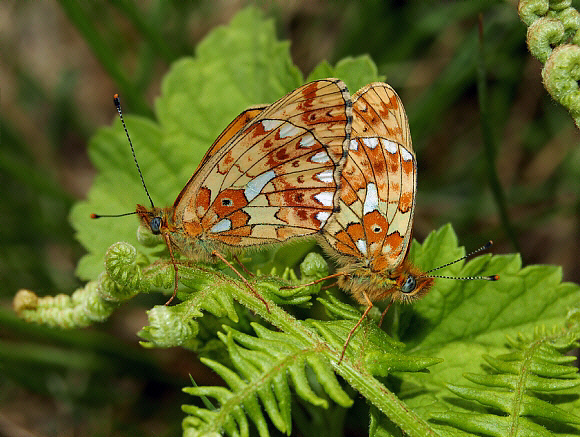
Pearl-bordered Fritillary Clossiana euphrosyne, copulated pair, Hampshire – Adrian Hoskins
Introduction
The English name of this beautiful and increasingly rare species is derived from the row of silvery spots around the borders of the underside hindwings. The Latin name refers to Euphrosyne, the Greek goddess of Joy, and one of the three Graces.
| Although the Pearl-bordered & Small Pearl-bordered Fritillaries bear a superficial resemblance to the Marsh, Heath and Glanville Fritillaries they belong to different subfamilies. The latter 3 species are members of the Melitaeini – a tribe within the Nymphalinae. The genus Clossiana however is placed in the Argynnini, part of the sub-family Heliconiinae, a group which includes the Heliconius Longwings of South America, the Acraeini of Africa, and the Argynnini of the Holarctic region. |
The Pearl-bordered Fritillary is found across most of Europe but is absent from most of Ireland, and from Portugal and southern Spain. It is tolerant of cool climates, it’s range extending to northern Sweden, and across temperate Asia as far as the Tien Shan mountains.
It is often found at the same sites as the closely related Small Pearl-bordered Fritillary, but prefers drier conditions. The flight periods of the 2 species overlap, so worn specimens of euphrosyne can be seen in the company of fresh specimens of selene. The latter can easily distinguished by looking at the undersides, which have additional silver spots in the median area, and distinct black chevrons on the inner edge of the submarginal silver spots. The uppersides of selene have darker veins and more linear markings than euphrosyne.
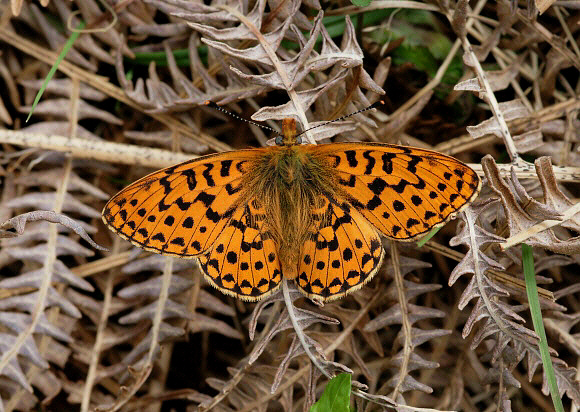
Pearl-bordered Fritillary Clossiana euphrosyne, male, Hampshire – Adrian Hoskins
The flight period of the Pearl-bordered Fritillary is variable according to season, usually from early May until early June, but the butterflies can emerge in mid-late April in forward seasons, hence the old name “April Fritillary”. Click here to see the historic names of all British butterflies.
Habitats
The Pearl-bordered Fritillary was formerly widespread in Britain, and in the 1960’s was still regarded as fairly common in woods throughout England and Wales – in fact it was quite difficult then to find a wood where the butterfly did not occur. In the last 40 years however it has contracted it’s range dramatically – a result of the virtual cessation of coppice management in woodlands. Coppicing created a profusion of violets and nectar sources such as bugle, which are essential to the survival of the butterfly.
Neglect of historically coppiced woods and the coniferisation of almost all Forestry Commission land has eliminated most colonies in Britain. Populations continue to decline rapidly, and local extinctions are increasing. The butterfly now only occurs at about 70 sites in Britain, mainly in western counties of England, Wales and Scotland.
The butterflies breed in lightly wooded habitats where dog violets or marsh violets grow in profusion in small sheltered clearings, and where bracken is present but not dominant. Typical sites include hazel coppice, clearings and wide rides in coniferous or deciduous woodland, limestone pavements, and around the northern shores of Scottish lochs.
A typical colony in a small actively coppiced wood will contain less than 20 adults at peak season. In large Forestry Commission woodlands the butterfly is restricted to often very small areas where the foodplants and nectar sources thrive, e.g. where rides have been recently widened, or where new clearings have been created. These habitats are ephemeral by nature, and are only really suitable for the butterfly in the 2-4 years after felling and clearing takes place.
After that they quickly become overgrown, the foodplants and nectar sources get shaded out, and the butterflies disappear unless they can locate and colonise another suitable breeding area nearby. When the habitat is in perfect condition, and climatic conditions are ideal, huge populations of up to 1000 Pearl-bordered Fritillaries can build up in 2 or 3 years. Unfortunately they are short-lived, and numbers can drop to tens within 1 or 2 years, or disappear entirely, once the regrowth shades out the foodplants.
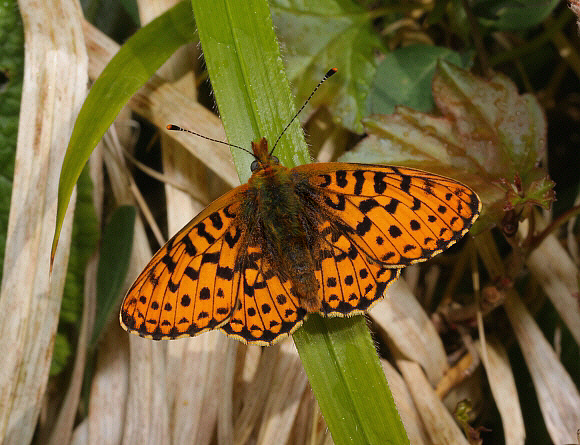
Pearl-bordered Fritillary Clossiana euphrosyne, male, Hampshire – Adrian Hoskins
Lifecycle
The butterflies lay their eggs singly or in pairs on dry bracken or dead grasses, choosing sheltered and semi-shaded situations where violets grow in profusion.
The larvae hatch after about 2 weeks, feeding diurnally on the leaves of dog violet Viola riviniana. In northern Britain V. palustris is more commonly used, and in Europe V. odorata and V. hirta are also commonly used.
In September when in the 4th instar they enter hibernation amongst leaf litter. The following spring, usually in late March, they awaken. On sunny days they can sometimes be seen basking on dead bracken and oak leaves on the forest floor. They continue feeding on violet leaves, becoming fully grown in April. The mature larvae are black, adorned with bright yellow-orange spikes along the back. In mid April they wander in search of a pupation site. The greyish brown pupa hangs by the cremaster from a dry stem, close to the ground.
Occasionally a partial 2nd brood emerges in August but this is extremely unusual in Britain even in very warm summers.
Adult behaviour
On sunny mornings male Pearl-bordered Fritillaries fly rapidly and in broad circles, with a flit-and-glide motion, just above the herb layer. They periodically dip down to gorge themselves on the nectar of their favourite flowers – bugle. When feeding they adopt a head-downwards posture, as they have a short proboscis and cannot easily reach into the flowers when in an upright position. They occasionally visit other flowers including ground ivy, wood anemone and dandelion; and in the New Forest I once saw one nectaring at hawthorn blossom.
Male-male encounters result in a brief dog-fight lasting only a few seconds, after which each goes their separate way.
The females are probably mated very soon after emergence, and in many cases before their maiden flight. Copulation takes place in late morning or early afternoon, and lasts about an hour. Afterwards the females spend most of their time delicately fluttering in and out amongst areas of dry grass and dead bracken, searching for egg-laying sites. They are capable of a fair turn of speed if disturbed however.
In cloudy but bright weather, both sexes spend short periods basking, sometimes on logs or bare earth, but more commonly on dead bracken. Overnight, or in heavily overcast weather, they roost in sheltered situations, typically on bracken fronds, on the dead flower-heads of St Johns wort, or on the leaf buds of pine saplings. In wet weather they roost tucked under dead bracken and leaf litter.
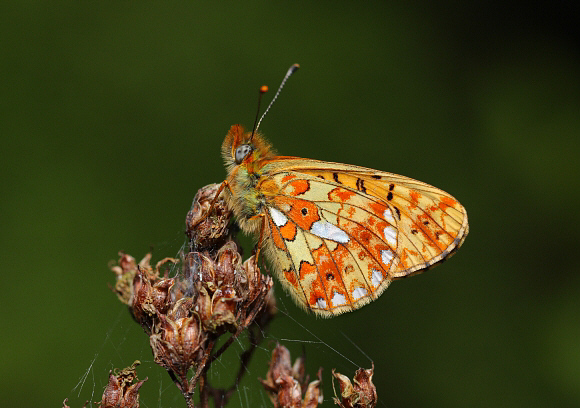 Pearl-bordered Fritillary Clossiana euphrosyne, male at roost, Hampshire – Adrian Hoskins
Pearl-bordered Fritillary Clossiana euphrosyne, male at roost, Hampshire – Adrian Hoskins
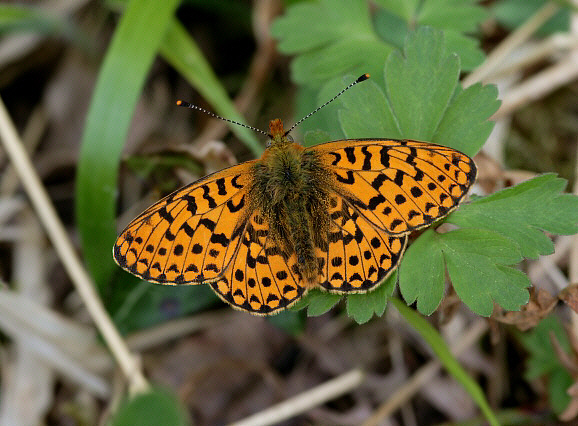 Pearl-bordered Fritillary Clossiana euphrosyne, male at roost, Hampshire – Adrian Hoskins
Pearl-bordered Fritillary Clossiana euphrosyne, male at roost, Hampshire – Adrian Hoskins
